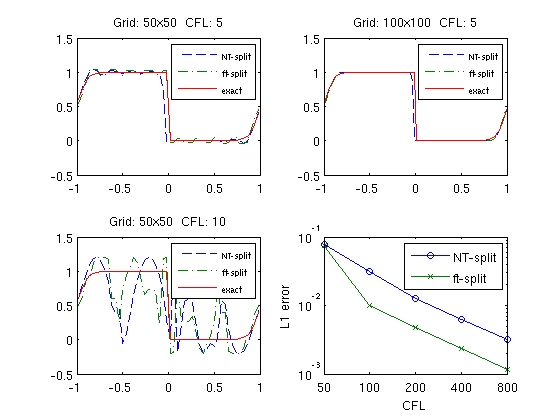Example 5.20: Source Splitting
A test of source splitting for the equation

with the initial values

The true solution is u(x,t)=u(x-t/2,0).
In the operator splitting, we use two substeps,


and construct the approximate solution from the formula
![$$u(x,t)\approx [S(\Delta t/2) \circ G(\Delta t) \circ S(\Delta t/2) ]^n u_0(x)$$](testSS_eq43099.png)
The hyperbolic step will be solved using the front-tracking method and the second-order nonoscillatory NT scheme. For the ODE step, we use forward Euler.
Initialize
addpath ../Dimsplit/
T = 8.0;
Kappa = 20;
xmin = -1; xmax=1;
Compare NT and front tracking
In the first example, we consider two grids with 50 and 100 cells and use a splitting step corresponding to CFL numbers 5 and 10.
for i=1:4 CFL = 10/((i<3) + 1); N = 50*(2-mod(i,2)); delta = 1/sqrt(N); h = (xmax-xmin)/N; x = xmin:h:xmax; y = 0.5*(x(1:end-1)+x(2:end)); Nstep = ceil(T/(h*CFL)); u0 = initialfunc(y,Kappa); t = linspace(0,T,Nstep+1); U = SourceSplit(u0, x,'burgerRsol','source', delta, Nstep, T,... 'periodic',[xmin xmax],'wbar','kappa',Kappa,'fronttrack'); uf = U(Nstep+1,:); U = SourceSplit(u0,x,'burgerRsol','source',delta, Nstep, T,... 'periodic',[xmin xmax],'wbar','kappa',Kappa,'central'); subplot(2,2,i), plot(y,U(Nstep+1,:),'--',y,uf,'-.',y,U(1,:)) h = legend('NT-split','ft-split','exact'); set(h,'FontSize',6), axis([-1 1 -0.5 1.5]) title(sprintf('Grid: %dx%d CFL: %d', N, N, CFL)); end

From the figure, we clearly see that highly inaccurate solutions are produced for both methods unless we have a sufficent grid resolution and a sufficient number of time steps. We notice that the front-tracking method gives a more accurate resolution of the shock than the NT scheme.
% NHR: please check what happens when CFL = 2.5 in the example above for % the front-tracking solution.
Effects of the CFL number.
Let us now investigate more closely the effects of varying CFL numbers
N = 200; delta = 1/sqrt(N); h = (xmax-xmin)/N; x = xmin:h:xmax; y = 0.5*(x(1:end-1)+x(2:end)); u0 = initialfunc(y,Kappa); ft_err=zeros(1,7); cn_err=ft_err; for k=1:7, CFL=2^(k-2); Nstep=ceil(T/(h*CFL)); U=SourceSplit(u0,x,'burgerRsol','source',delta,Nstep,T,... 'periodic',[xmin xmax],'wbar','kappa',Kappa,'fronttrack'); ft_err(k)=h*sum(abs(U(Nstep+1,:)-U(1,:))); U=SourceSplit(u0,x,'burgerRsol','source',delta,Nstep,T,... 'periodic',[xmin xmax],'wbar','kappa',Kappa,'central'); cn_err(k)=h*sum(abs(U(Nstep+1,:)-U(1,:))); end; semilogy(-1:5,cn_err,'-o',-1:5,ft_err,'-x'); set(gca,'XTick',-1:5,'XTickLabel',2.^(-1:5)); xlabel('CFL'); ylabel('L1 error'); legend('NT-split','ft-split');

Grid refinement
Finally, we set the CFL number to 5 and conduct a grid-refinement study.
CFL=5; ft_err = zeros(1,5); cn_err = ft_err; for k=1:5, N = 50*2^(k-1); delta = 1/sqrt(N); h = (xmax-xmin)/N; x = xmin:h:xmax; y = 0.5*(x(1:end-1)+x(2:end)); u0 = initialfunc(y,Kappa); Nstep=ceil(T/(h*CFL)); U=SourceSplit(u0,x,'burgerRsol','source',delta,Nstep,T,... 'periodic',[xmin xmax],'wbar','kappa',Kappa,'fronttrack'); ft_err(k)=h*sum(abs(U(Nstep+1,:)-U(1,:))); U=SourceSplit(u0,x,'burgerRsol','source',delta,Nstep,T,... 'periodic',[xmin xmax],'wbar','kappa',Kappa,'central'); cn_err(k)=h*sum(abs(U(Nstep+1,:)-U(1,:))); end; semilogy(0:4,cn_err,'-o',0:4,ft_err,'-x'); set(gca,'XTick',0:4,'XTickLabel',50*2.^(0:4)); xlabel('CFL'); ylabel('L1 error'); legend('NT-split','ft-split'); ft_rate=log(ft_err(1:end-1)./ft_err(2:end))/log(2); sft=strcat('Front track rate:',sprintf(' %3.2f',ft_rate)); cn_rate=log(cn_err(1:end-1)./cn_err(2:end))/log(2); scn=strcat('Central rate :',sprintf(' %3.2f',cn_rate)); disp(sft); disp(scn);
Front track rate: 2.90 1.04 1.02 1.01 Central rate : 1.34 1.29 1.01 1.00

rmpath ../Dimsplit/